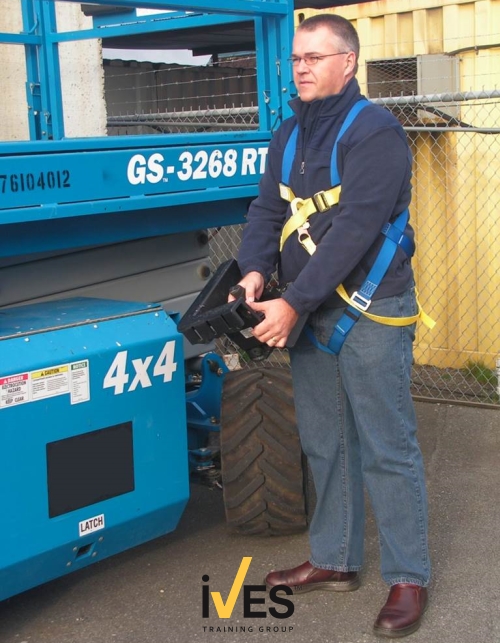Hello again! We know you’re busy, but there’s some great stuff in this newsletter edition, so hopefully you’re a fast reader. This month you’ll find,
- Our feature article covering three important goals every trainer should have.
- Information on a RT forklift quiz answer revision.
- A new What’s Wrong With This? photo.
- An answer to last month’s WWWT?.
- An Ask Bob question on stand-up forklifts.
- A sentencing report for a company who removed a kill switch.
- A heads up for DTA users.
- A list of upcoming events.
- And a few testimonials from our fantastic clients.
What, How & Why: The Big Three of Operator Training
Operating a forklift, aerial lift or loader is not a one dimensional activity. Operators must be able to correctly interpret information regarding their equipment, load, environment and application. They must then use that information to determine how the equipment controls are manipulated. That being said, training of such operators is not one dimensional either! A trainer must break things down into three dimensions in order to get an operator to the desired levels of knowledge, understanding and skill. The three goals of training are getting across the what, how and why. Let’s talk a bit about each…
WHAT must be done. This is a basic premise but one that is surprisingly often overlooked or underestimated. Trainees must have a clear understanding of what it is they are expected to do. A great help here is to walk your trainees through what is expected of them before asking them to do anything. Doing this will provide them with consistent, accurate information and give them the opportunity to ask questions.
HOW to do it. This phase of a training program is the actual training itself. It involves the trainer’s instruction along with the physical use of the equipment by the trainees as they make the mental and physical connection between their actions and the reactions of the equipment.
WHY it is done. Without question, this is the most important phase. Nothing enhances a trainee’s motivation to do something more than understanding the rationale of why it should be done. Citing regulations, industry standards or company policy here will not do the trick in place of providing the reason why. Bottom line, trainees are far more likely to adhere to their training if they understand why they should. There is a reason for everything and those reasons need to be conveyed to each operator.
These three points must be expressed throughout both theory and practical training. Trainers should be ensuring understanding on an ongoing basis. In the classroom, this is achieved through active engagement and interaction with the trainees. In the field, understanding is achieved through practical demonstrations performed by the trainee with the equipment. If trainers are able to effectively convey these three goals, they will have paved the way to the door of the ultimate goal: understanding.
Reflect on your own training program… Are you addressing the what, how and why with your trainees? Make sure to catch next month’s newsletter where we address Basic Traits of an Effective Trainer in our follow up feature article.
Rob Vetter
Director of Training
IVES Training Group
Material Revision Notice
A mistake was made in the answer key in regards to quiz question #3 of page 48 of the RT Forklift Operator’s Reference Manual. The answer to the question is incorrectly listed as 30 degrees when it should be -4 degrees (that’s negative four).
The mistake has been caught and corrected. A revised copy of the affected page in the answer key has been posted on the Member Dashboard in the Downloadable Materials and Updates.
Answer to January’s WWWT?
Last month we showed you a boomlift operator hanging materials over the railing of the work platform.
Per the ANSI Standards, A92.5-2006 Manual of Responsibilities, Section 7.10 Operator Warnings and Instructions, (20) Misuse as a crane. The aerial platform shall not be used as a crane.
Slinging materials off the side of a machine (or any part of the boom or platform) can cause instability and may possibly result in a tip-over. The proper procedure would be to lower the basket, retrieve the materials and carry them within the platform. A few extra minutes of your time will ensure you and your co-workers all get home safely.
Did you know? It is required by law that all aerial work platforms have a copy of the applicable ANSI A92 Manuals of Responsibilities standard on the machine in the weather resistant storage compartment. These manuals must be read and understood by equipment operators or explained to them in a language they understand.
What’s Wrong With This?
You know the drill! Okay, maybe you don’t… Take a look at the photo and try to figure out what this scissor lift operator is doing wrong. We’ll share our answer in the March IVES Update Newsletter. You can also post your answers on our Facebook page.

Have a photo that you’d like to see in the IVES What’s Wrong With This? Email it to us at info@ivestraining.com. Maybe your picture will be featured in an upcoming edition!
Ask Bob
 Hi, one of our instructors has told me that when loading into a trailer while driving a stand-up counterbalanced forklift that if the employee feels the trailer move that they should jump out of the machine as the trailer may move far enough and the machine will tip over. He said they could only perform this on the dock while they are loading and or unloading. I just want to make sure that this is correct for when we are training out employees. Thanks, Joe.
Hi, one of our instructors has told me that when loading into a trailer while driving a stand-up counterbalanced forklift that if the employee feels the trailer move that they should jump out of the machine as the trailer may move far enough and the machine will tip over. He said they could only perform this on the dock while they are loading and or unloading. I just want to make sure that this is correct for when we are training out employees. Thanks, Joe.
Thanks for your question, Joe. Unlike sit-down units, operators of stand-up units are indeed advised to step off the rear of the machine if they feel a tip-over is imminent. However to be clear, if the operator is inside a trailer with the forklift and the trailer itself is tipping over then the operator should stay in the forklift. Hope that clarifies things. Bob.
Upcoming Events
IVES will be exhibiting at the following trade shows and conferences:
- April 22-23. 2013 Western Conference on Safety
- May 7-10. Region VI VPPPA Chapter Conference
- June 24-26. ASSE 2013 Annual Conference & Exposition
- August 26-29. 29th Annual National VPPPA Conference
Busted!
A California farm manager on trial for removing a safety device on a tractor resulting in the death of a vineyard worker has been sentenced to 30 days in jail and 80 hours of community service.
The manager ordered the “kill switch” to be removed from a tractor used at the vineyard. The switch shuts the machine off when the driver leaves the seat. When an employee’s clothing was caught while he was trying to get out of the tractor, he was pinned underneath the vehicle overnight, resulting in injuries from which he died days later. The accident could have been prevented had the switch not been removed from the tractor.
In addition to the jail time he will serve, his plea bargain in the case means the vineyard faces fines and restitution fees to the victim’s family reaching $200,000. The accused pleaded no contest to a misdemeanor violation of a labor code prohibiting the removal of safety devices.
“All workers have the right to expect that they will come home at the end of the work day and that their employers will keep in place all manufacturers’ safety devices on equipment used for work,” District Attorney Ravitch said. “Companies and supervisors who disable safety devices will be held accountable for the sake of workers who depend on them.” - Source: OH&S
Heads Up: Digital Training Aid Users
Are you using the Downloadable Version of our DTA? No? You should be. Check it out! If you are using the Downloadable Digital Training Aid, that’s great! Now, listen up. If you’ve upgraded to Adobe Reader 11.0 you will need to install a new plug-in for compatibility reasons. Don’t worry, it’s free – you can download it here.
Client Testimonials
Bill from General Paint says, “I have been associated with IVES Training for 25 years and they are 1 of only 2 companies that I consistently recommend without hesitation.”
“I would recommend this program to others. This was a great opportunity for me and my company,” said Vincent, IVES Certified Trainer at Foremost Foods.
Sandra at Toys R Us says, “Your trainer was well prepared, able to give good examples and discuss relevant situations. I appreciate that this was geared to our environment and situation.”
“I thought the program was engaging and well run. At first I felt a little nervous training or becoming a trainer, but after completion of this program I feel educated, competent, and inspired to improve workplace safety with effective training,” said Jerry at Whole Foods Market.
Did you enjoy this newsletter? Sign up for our newsletter to receive more like this!